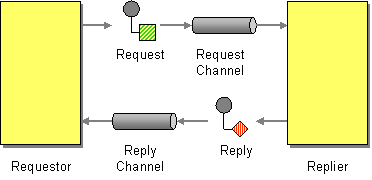Since we're on a major migration process of this website, some component documents here are out of sync right now. In the meantime you may want to look at the early version of the new website
https://camel.apache.org/staging/
We would very much like to receive any feedback on the new site, please join the discussion on the Camel user mailing list.
Request ReplyCamel supports the Request Reply from the EIP patterns by supporting the Exchange Pattern on a Message which can be set to InOut to indicate a request/reply. Camel Components then implement this pattern using the underlying transport or protocols.
For example when using JMS with InOut the component will by default perform these actions
Related See the related Event Message message Explicitly specifying InOutWhen consuming messages from JMS a Request-Reply is indicated by the presence of the JMSReplyTo header. You can explicitly force an endpoint to be in Request Reply mode by setting the exchange pattern on the URI. e.g. jms:MyQueue?exchangePattern=InOut You can specify the exchange pattern in DSL rule or Spring configuration. Error formatting macro: snippet: java.lang.IndexOutOfBoundsException: Index: 20, Size: 20
Error rendering macro 'code': Invalid value specified for parameter 'java.lang.NullPointerException'
<camelContext xmlns="http://camel.apache.org/schema/spring">
<!-- Send the exchange as InOnly -->
<route>
<from uri="direct:testInOut"/>
<inOut uri="mock:result"/>
</route>
<!-- Send the exchange as InOnly -->
<route>
<from uri="direct:testInOnly"/>
<inOnly uri="mock:result"/>
</route>
<!-- lets set the exchange pattern then send it on -->
<route>
<from uri="direct:testSetToInOnlyThenTo"/>
<setExchangePattern pattern="InOnly"/>
<to uri="mock:result"/>
</route>
<route>
<from uri="direct:testSetToInOutThenTo"/>
<setExchangePattern pattern="InOut"/>
<to uri="mock:result"/>
</route>
<route>
<from uri="direct:testSetExchangePatternInOnly"/>
<setExchangePattern pattern="InOnly"/>
<to uri="mock:result"/>
</route>
<!-- Lets pass the pattern as an argument in the to element -->
<route>
<from uri="direct:testToWithInOnlyParam"/>
<to uri="mock:result" pattern="InOnly"/>
</route>
<route>
<from uri="direct:testToWithInOutParam"/>
<to uri="mock:result" pattern="InOut"/>
</route>
</camelContext>
Using This PatternIf you would like to use this EIP Pattern then please read the Getting Started, you may also find the Architecture useful particularly the description of Endpoint and URIs. Then you could try out some of the Examples first before trying this pattern out. |

